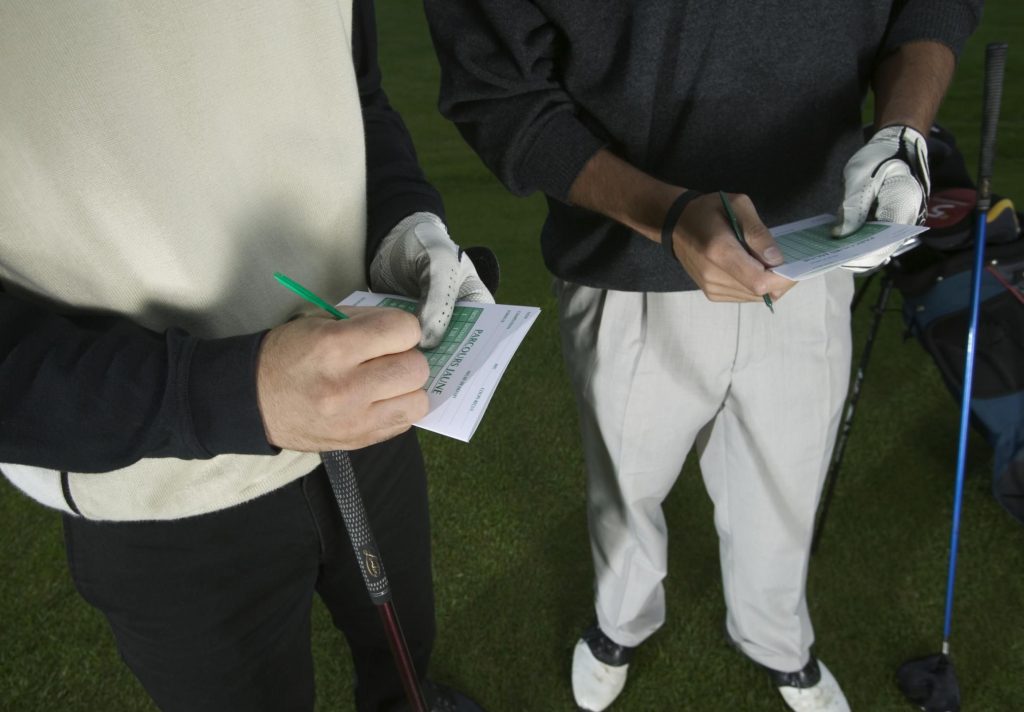The term handicap is often heard in golf, yet many newcomers are unsure what it really means. Literally translated it might suggest a “disability,” but in the context of golf the word has a very different—and far more positive—meaning. Here are GoGolf explanation.
Definition of a Golf Handicap

A golf handicap is a scoring system that adjusts a player’s score to their ability, allowing golfers of different skill levels to compete on equal terms.
- A lower handicap signals a more skilled golfer.
- A higher handicap indicates a beginner or less-skilled player.
In practice, a handicap is a single number that represents an amateur golfer’s playing ability, calculated from their net score (strokes played minus handicap). Because it is aimed at amateurs, the system is not used on professional tours.
Why Have a Handicap?
- Benchmark your skill – Players know where they stand and can join events matched to their level.
- Fair pairing – A big-handicap player is unlikely to tee up with someone whose handicap is much lower unless the event adjusts strokes.
- Varies by country – Each nation or club can set its own rules, though most now follow the World Handicap System (WHS).
What Is a “Single Handicap”?
A single-handicap golfer carries a handicap index below 10.0—single digits (1–9). This marks the player as highly competent and consistent.
| Category | Handicap Index | Skill Level |
|---|---|---|
| Single Handicap | 1.0 – 9.9 | Advanced, experienced |
| Scratch Golfer | 0.0 | Near-professional |
| Bogey Golfer | 18.0 – 28.0 (women) | Typical amateur |
👉 A single-handicap player typically shoots 72–81 on a par-72 course—day in, day out.
What Does Single Handicap Imply?
- Solid technique – Reliable swing, putting, approach shots, and course management.
- Stable scores – Only a few strokes over par, even on tough layouts.
- Tournament ready – Often eligible for higher-level amateur events.
- Discipline required – Regular practice and performance reviews are essential to keep it.
Why Handicaps Matter
✅ Level the field – A pro with handicap 2 might “give” strokes to a beginner at handicap 20 so both finish with comparable net scores.
✅ Track progress – Players watch their index rise or fall as their game changes.
✅ Used in many formats – Match play, stroke play, scrambles, especially at club or amateur level.
✅ Entry requirement – Many local, regional, even national events insist on an official handicap.
Unlock golf’s best deals—download GoGolf App today
How the Handicap System Works

Since 2020, golf has operated under the World Handicap System (WHS)—a single global standard. It lets golfers of every skill band compete fairly by factoring in course difficulty and personal ability.
Building Blocks
| Component | Meaning |
|---|---|
| Gross Score | Total strokes for 18 holes |
| Adjusted Gross Score | Gross score capped by max strokes per hole (Equitable Stroke Control) |
| Course Rating | Expected score by a scratch (0-handicap) player |
| Slope Rating | Course difficulty for non-scratch players (55–155; 113 = average) |
| Handicap Index | Average of the eight best differentials from a player’s last 20 rounds |
| Course Handicap | Handicap Index adjusted to a specific course |
Course Rating estimates what a scratch golfer should shoot; Slope Rating tells how tough the track is for everyone else—the higher the slope (max 155), the harder it plays for amateurs.
Formula Snapshot
Handicap Differential = [((Score − Course Rating) × 113) ÷ Slope Rating]
The Index is the average of your eight best differentials out of the past 20 rounds.
Quick Example
- Player shoots 92
- Course Rating 72.0
- Slope 130
Handicap Differential
[((92 − 72) × 113) ÷ 130] ≈ 17.38
Do this for every round, average the best eight of 20, and you have your official Handicap Index.
In-Match Illustration
- Player A: handicap 10
- Player B: handicap 18
- Difference: 8 strokes ➔ Player B receives one extra stroke on each of the eight most difficult holes.
If B shoots 90 and A shoots 85:
- Net B = 90 – 8 = 82
- Net A = 85 – 0 = 85
Player B wins on net score.
Computing a Starter Handicap (Classic Method)
Many clubs once took the average of a golfer’s three best 18-hole scores, then subtracted the Standard Scratch Score (SSS) for the course. Example:
- Scores: 80, 86, 95 → Average = 87
- SSS = 70
- Handicap = 87 − 70 = 17
Maximums
- Men: 28
- Women: 36
Lower is always better.
Handicap Categories (Traditional)
| Category | Handicap Range | Adjustment Factor |
|---|---|---|
| 1 | ≤ 5 | 0.1 |
| 2 | 5.5 – 12.4 | 0.2 |
| 3 | 12.5 – 20.4 | 0.3 |
| 4 | 20.5 – 28 | 0.4 |
| 5* | 28.1 – 36 (women) | 0.5 |
*Category 5 historically applied mainly to female golfers.
Official Recognition & Adjustments
You can certify a handicap through a national body—e.g., the USGA—for a modest fee. Handicaps fluctuate: play better than your number and it drops; play worse and it may rise. Example: beat your handicap by two shots and the index is trimmed by 2 × the factor for your category.
Description: A handicap mirrors a golfer’s average scoring ability. Its purpose is to create a level playing field within any group.
[ Follow our social media Account: GoGolf Instagram | GoGolf Facebook | GoGolf X ]











